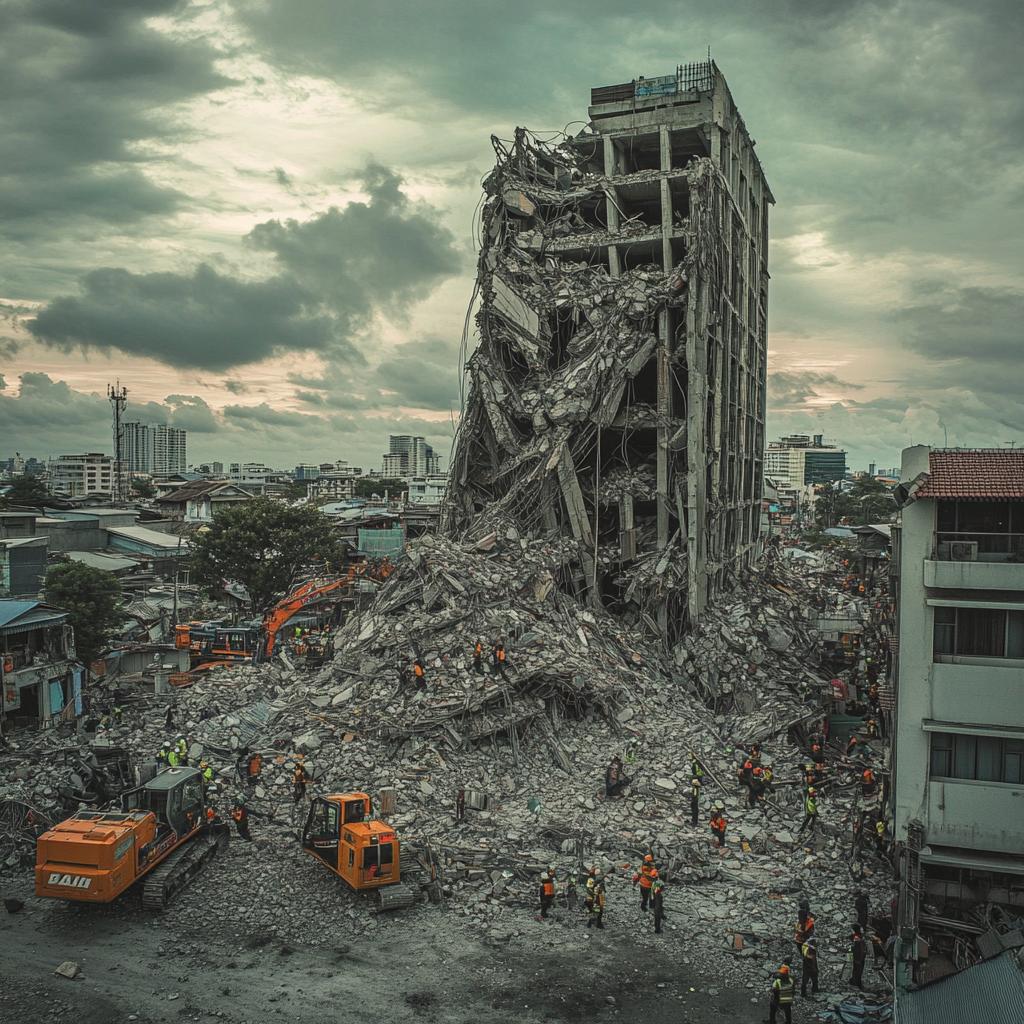The city of Bangkok has been thrown into deep turmoil following a catastrophic incident that is etched in its recent history. On that fateful day of March 28, the arid construction site of the State Audit Office (SAO) building, nestled on Kamphaeng Phet 2 Road, stood unfinished, its future abruptly recast by the tremors of an unpredictable Earth. An 8.2-magnitude earthquake, with its epicenter near Mandalay, Myanmar, proved too great a force, causing the partially constructed SAO building to crumble in a matter of harrowing moments, leaving over one hundred brave souls trapped amidst the debris.
The city has not been silent in its response. The Bangkok Metropolitan Administration (BMA) has been on the front lines, documenting and reacting to the scope of the devastation. Reports from the BMA on the Friday following the tragedy described a heart-wrenching scene within the fire escape stairwell area, where they continue to recover the bodies of those lost, and anticipate more may still be found as their arduous operations press on.
To date, the BMA has borne witness to the shocking tally of 103 victims from this incident. Of these, the heart of the city cries for the 60 lives confirmed to have perished, while nine individuals have emerged injured yet alive, clinging to recovery, and dishearteningly, 34 souls remain unaccounted for in this shadowy aftermath.
The rescue and demolition efforts have been a race against time and adversity, with a recent notable achievement: the towering piles of rubble, initially a formidable 5.77 meters high, have been gradually diminished to approximately 4.3 meters, as every inch cleared represents renewed hope and progress towards closure. This meticulous plan is set in motion with the aim of unveiling the building’s first floor before the end of April—an endeavor that stands as a testament to human resilience.
The path forward is fraught with challenges. The logistical dance is hindered by unavoidable traffic disruptions, which have forced changes in strategy and necessitated the mobilization of additional support. In response, military personnel along with an arsenal of construction equipment have been deployed to aid in this mission. An ambitious, yet carefully calculated plan awaits: once the crews reach the basement, the city will pivot to broadening the structural openings both at the front and sides of the building. This adaptation is crucial, for it not only enhances the safety and efficiency of debris removal but also ensures that no lives remain ensnared within the foreboding confines of the fallen structure.
In the spirit of resilience and support, the BMA has extended a gesture of compassion—prolonging the deadline for disaster relief applications to May 2. This extension offers grace to those affected who found themselves unable to apply amidst the vibrant yet overpowering chaos of the Songkran holidays.
The response has been substantial, with a staggering 39,127 individuals coming forward to seek aid. Notably, Chatuchak district has recorded the highest number of applications, with 5,167 individuals in need, underscoring the widespread impact of this catastrophe.
In times of struggle, the city of Bangkok proves once again that community and concerted effort shine brightest in the darkest hours. As these operations continue, the hope remains that the city will not only rebuild structurally but also heal the emotional and spiritual wounds of its people, chasing the light of recovery and renewal through the labyrinth of debris and adversity.


















This is heartbreaking. It seems like the BMA is really trying their best. The dedication of the rescue teams is truly inspiring.
I agree, but I can’t help wonder if this tragedy could’ve been avoided with better construction standards.
That’s a valid point, Sandra. Perhaps stricter regulations could prevent future tragedies like this.
Or it could be a natural disaster no one could have predicted or prepared for.
Over 39,000 people seeking aid? That’s astonishing. It highlights not just the scale of the tragedy but also how many people were unprepared for such an event.
Exactly, Larry. There’s a dire need for improved disaster preparedness and community awareness programs.
Yes, we need a systemic change in how cities handle such emergencies.
I don’t know, what is the point of rebuilding if this can happen again? It’s just putting a Band-Aid over a wound that needs stitches.
But isn’t rebuilding part of healing, grower134? Cities evolve and learn from these tragedies.
That’s true, but I hope they actually learn and apply stricter measures this time.
It’s incredible how the city came together during such dark times. This is what true community looks like.
True, but I’m skeptical. It’s always the poor who suffer the most in these situations.
That’s a fair point. We need to ensure that relief reaches those who need it most.
Are military personnel really necessary for these operations? Seems a bit much to me.
I think they are. It’s all hands on deck in such an unprecedented disaster.
I guess, but civilian aid groups might be more efficient in non-combat scenarios.
The emotional toll on families must be unbearable. Recovery is about more than just removing debris; it’s about healing hearts.
Rescue first, ask questions later. Right now recovery should be the only focus.
Agreed, jess. Yet once this is over, serious questions about safety standards must be asked.
I wonder if the postponed disaster relief application deadline will make a difference.
It might. Prolonging deadlines allows more people to get the help they desperately need.
Would this really be more devastating than other disasters worldwide, or are we just paying more attention this time?
Every disaster is devastating for those it affects. It’s difficult to compare suffering.